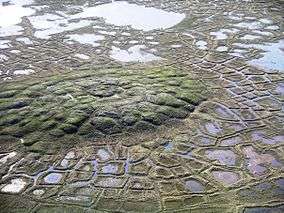Ice wedge


An ice wedge is a crack in the ground formed by a narrow or thin piece of ice that measures up to 3–4 meters in length at ground level and extends downwards into the ground up to several meters. During the winter months, the water in the ground freezes and expands. Once temperatures reach −17 degrees Celsius or lower, the ice that has already formed acts like a solid and expands to form cracks in the surface known as ice wedges. As this process continues over many years ice wedges can grow, up to the size of a swimming pool. Ice wedges usually appear in a polygonal pattern known as ice wedge polygons. The cracks can also be filled with materials other than ice, especially sand, and then they're called sand wedges.
Formation
There are many theories that attempt to explain the origin of ice wedges but only one has been consistently supported by most prominent scientists: the thermal contraction theory.
Thermal contraction theory
The thermal contraction theory states that during the winter months, thermal contraction cracks form only a few cm wide and a couple of metres deep because of the extreme cold weather.[1] Over the next few months, the snow melts and the remaining water fills the cracks and the permafrost below the surface freezes it. These tiny cracks turn into permafrost. Once the summer months arrive, the permafrost expands; horizontal compression produces upturning of the frozen sediment by plastic deformation. The next winter the cold refreezes and cracks the already forming ice wedge, opening a way for the melting snow of spring to fill the empty crack. The mean annual air temperature thought needed to form ice wedges is −6° to −8°C or colder.[2]
Forms
There are three different forms of ice wedges: active, inactive and casts. All three forms are prevalent today and can be found in different parts of the world.
Active
Active ice wedges are those that are still evolving and growing. During each year, a layer of ice will be added if cracking occurs, but cracking need not occur every year to be considered active. The area in which most ice wedges remain active is along the permafrost zone. The number of active ice wedges that are cracking yearly is consistently declining as they become inactive.[3]
Inactive
Inactive ice wedges are wedges that are no longer cracking and growing. Throughout the winter months, the wedge does not split and therefore in the summer no new water is added.[3]
Casts
In areas of past permafrost, ice wedges have melted and are no longer filled with ice. The wedge, which is now empty, is filled with sediment and dirt from the surrounding walls. These are called ice wedge casts and are used to estimate the climate of hundreds of thousands of years ago.
References
| Wikimedia Commons has media related to Ice wedges. |
- ↑ "Ice wedges, polygons and pingos". Arctic National Wildlife Refuge. U.S. Fish & Wildlife Service - Alaska. 2006-02-14. Retrieved 2008-05-26.
- ↑ "Permafrost: Origins". Britannica Online Encyclopedia. Retrieved 2008-05-26.
- 1 2 "Permafrost: Active wedges, inactive wedges, and ice-wedge casts". Britannica Online Encyclopedia. Retrieved 2008-05-26.